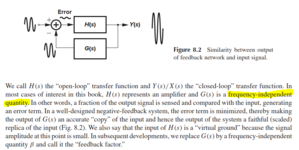melkord
Full Member level 3
In the system with negative feedback, what is described by G(s) actually? is it G(s)=A(s)/Y(s) ?
If I want to derive Y(s)/X(s), is it a correct way to derive G(s)=A(s)/Y(s) and then I can plug it in to the equation (8.2)?
With simple resistor as feedback, I usually derive the transfer function directly.
But right now, I have a quite complicated feedback network with some frequency-dependent components.
That's why I want to derive G(s) first.


If I want to derive Y(s)/X(s), is it a correct way to derive G(s)=A(s)/Y(s) and then I can plug it in to the equation (8.2)?
With simple resistor as feedback, I usually derive the transfer function directly.
But right now, I have a quite complicated feedback network with some frequency-dependent components.
That's why I want to derive G(s) first.
